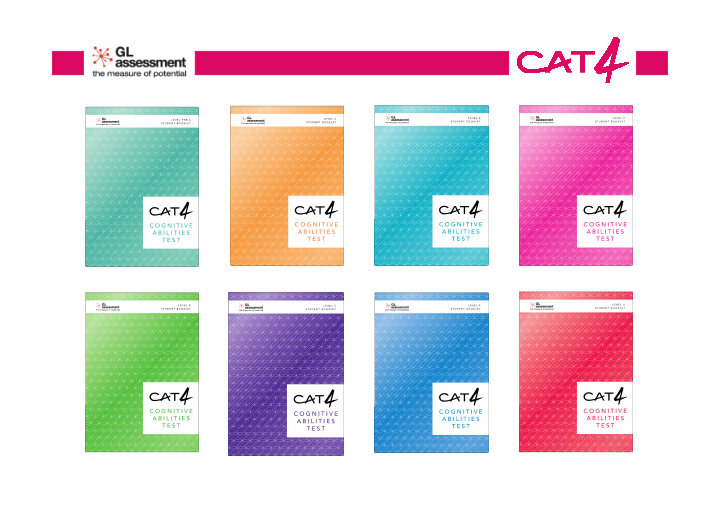



Why a new edition? ____________________________________________________________________________________________________________________________________________ • Research-based assessment • Structure of the assessment • Test content review – particularly verbal items for relevance • New standardisation
Customer research 2008-2009 ____________________________________________________________________________________________________________________________________________ What schools need from CAT4 and what it will deliver: • Guidance on communicating to parents/other teachers • Help with further analysis of data • Manageable test time • More accessible Getting the best from CAT • Clear examples (case studies) in simple language • Up to date indicators
CAT3 structure 3 Quantitative 3 Non-verbal 3 Verbal Number Analogies Figure Classification Verbal Classification Number Series Figure Analogies Verbal Analogies Equation Building Figure Analysis Sentence Completion 2 Non-verbal 2 Spatial 2 Quantitative 2 Verbal Number Analogies Figure Classification Figure Analysis Verbal Classification Figure Matrices (was Figure Recognition (New) Number Series Verbal Analogies Figure Analogies) CAT4 structure
Changed CAT3 subtests ____________________________________________________________________________________________________________________________________________ Verbal : Sentence Completion dropped – more dependent on reading skill and educational background. Quantitative : Equation Building dropped – more dependent on formal maths knowledge.
Changed CAT3 subtests ____________________________________________________________________________________________________________________________________________ Non-verbal : Figure Analogies retained but redrawn in 2x2 matrix format, to allow introduction of harder 3x3 items demanding more complex reasoning. Figure Analysis is not dropped but re-classified as a Spatial subtest.
Changed CAT3 subtests ____________________________________________________________________________________________________________________________________________ Spatial : Figure Recognition is a new subtest that necessitates creating, remembering and comparing precise mental images of shapes.
Non-verbal and Spatial ____________________________________________________________________________________________________________________________________________ Figure Classification & Figure Analysis & Figure Figure Matrices Recognition • Use both verbal and spatial • Involve creating, remembering thought processes in and mentally manipulating combination. precise mental images. • Good indication of overall • Difficulty lies in the visualising ability independent of reading aspect. skill or spoken English. • Good indication of potential to • Shape distinctions are easy so do well in particular subjects difficulty lies in the reasoning and careers. aspect.
Non-verbal Verbal Spatial Quantitative Pure Pure Hybrid extreme extreme 1. Verbal and Spatial are the ‘pure extremes’. 2. Non-verbal and Quantitative are hybrid batteries, which use both Verbal and Spatial to some degree, with that degree depending on the student’s inclinations. 3. Verbal and Quantitative are more likely to be affected by schooling to a greater degree than Non-verbal and Spatial.
Trialling in autumn 2010 ____________________________________________________________________________________________________________________________________________ 6 test booklets trialled in each year group. Around 300 students took each booklet. Year Number of students 4 2,028 6 1,870 8 2,179 10 2,114 Total 8,191
Standardisation in autumn 2011 ____________________________________________________________________________________________________________________________________________ The numbers in the national standardisation were as follows: Country Primary Secondary Total England 4,663 13,085 17,748 Wales 269 2,169 2,438 Scotland 259 2,439 2,698 Northern 179 1,645 1,824 Ireland Total 5,370 19,338 24,708
Standardisation in autumn 2011 ____________________________________________________________________________________________________________________________________________ Comparison with the national population: Country Primary Secondary Total National population England 87% 68% 72% 83% Wales 5% 11% 10% 5% Scotland 5% 13% 11% 8% Northern 3% 9% 7% 3% Ireland Total 100% 100% 100% 100%
Standardisation in autumn 2011 ____________________________________________________________________________________________________________________________________________ 21% of primary students did the digital version but the majority (69%) of secondary students did the digital version. Delivery mode Primary Secondary Total Digital 1,123 13,412 14,535 Paper 4,247 5,926 10,173 Total 5,370 19,338 24,708
Further studies / Indicators ____________________________________________________________________________________________________________________________________________ • Paper – Digital study • CAT3 – CAT4 equivalence study • Indicator updates
Benefits of CAT4 ____________________________________________________________________________________________________________________________________________ Verbal/spatial comparison offers a more clearly defined profile of a student’s learning bias or preference.
Benefits of CAT4 ____________________________________________________________________________________________________________________________________________ Group report for teachers is a single report which incorporates information formerly contained in several separate reports • Scores for students in a defined group with Standard Age Scores and Group Rank • Analysis of the group against the national average • Chart showing the distribution of different learning preference profiles across the group • Descriptors of each profile with listing of students who are in each category • Indicators of future attainment in national tests and exams
Benefits of CAT4 ____________________________________________________________________________________________________________________________________________ Individual report for teachers is supplemented by dedicated reports for students and parents – with appropriate narrative and implications for teaching and learning • Detailed breakdown of scores for each student including SAS with confidence bands, NPR, stanines and group rank • Profile description for each student indicating their learning preference with written implications for teaching and learning • Indicators of future attainment in national tests and exams
Benefits of CAT4 ____________________________________________________________________________________________________________________________________________ • Results less dependent on prior education – removal of sentence completion and equation building • Level G for students aged 16 to 18 – above average ability to reflect usage of CAT • Shorter test time • Streamlined teacher materials – all contained in the Teacher Guidance Pack
CAT4 reports – customer research 2011 ____________________________________________________________________________________________________________________________________________ • Reduce overall number of reports • Design reports by end user • Give sensible names • Include assessment overview information • Include statistical language explanations • Include more narrative
CAT4 reports ____________________________________________________________________________________________________________________________________________ Key finding • CAT data is used to baseline new students in secondary school, set targets, and identify gifted and talented/SEN students. Opportunity • To promote the further benefits of CAT , particularly regarding understanding the profiles of individual students. Objectives for new report design • Make clearer the profile information for a student, with narrative support taken from statement banks giving implications for teaching and learning .
CAT4 reports ____________________________________________________________________________________________________________________________________________ Key finding • CAT data is used by the Special Needs Coordinators and Senior Leaders. Opportunity • To support and encourage sharing of data with a wider group of stakeholders including classroom teachers, parents and students themselves. Objectives for new report design • Design reports by end user, including parents and students, with clear naming conventions.
CAT4 reports ____________________________________________________________________________________________________________________________________________ Key finding • CAT is infrequently triangulated with other data. Opportunity • To provide reminders of what the assessment is for and explain the value alongside other data. Objectives for new report design • Provide written summary explanations of the value of the assessment and how it can be used alongside other data.
Recommend
More recommend